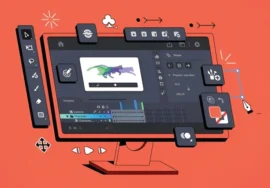
3D design has become an indispensable tool in the entertainment industry, transforming the way we experience movies, television shows, video games, and more. By creating immersive virtual worlds and bringing fantastical characters to life, 3D design has elevated the storytelling capabilities of filmmakers and game developers alike.
Here, we’ll delve into the various applications of 3D design in the entertainment industry, exploring how it enhances visual effects, character animation, and virtual production.
The Power of 3D Design
3D design empowers creators to visualize and construct intricate worlds that would be impossible to achieve with traditional film-making techniques. It allows for manipulating light, shadow, and perspective, resulting in hyper-realistic visuals that can transport audiences to distant planets, underwater kingdoms, or futuristic cities.
Key Applications of 3D Design in Entertainment
- Visual Effects.
- Creating Realistic Environments: 3D design enables the creation of photo-realistic landscapes, cityscapes, and natural phenomena. By modeling and texturing digital assets, artists can generate breathtaking backdrops for any scene.
- Designing Intricate Props and Sets: From ancient artifacts to futuristic gadgets, 3D design allows for the creation of detailed props and sets that enhance the visual appeal of a production.
- Animating Complex Creatures and Characters: 3D animation brings to life fantastical creatures, superheroes, and other imaginative characters. By rigging digital models with a skeletal structure and applying realistic motion capture techniques, animators can create lifelike performances.
- Character Animation.
- Developing Expressive Characters: 3D animation techniques enable animators to craft characters with nuanced facial expressions and body language, allowing for more authentic and emotional storytelling.
- Creating Believable Motion: By studying real-world movement and applying advanced animation principles, 3D animators can generate fluid and convincing character animation.
- Enhancing Performance Capture: 3D design tools can refine and enhance motion capture data, resulting in more precise and realistic character performances.
- Virtual Production.
- Real-Time Rendering: Virtual production techniques allow filmmakers to visualize scenes in real time, enabling directors to make creative decisions on set.
- Immersive Environments: By combining virtual sets with real-world actors, filmmakers can create immersive environments that blend with the physical world.
- Efficient Production Workflows: Virtual production streamlines the filmmaking process by reducing the need for physical sets and special effects.
The Future of 3D Design in Entertainment
As technology continues to advance, the possibilities for 3D design in the entertainment industry are limitless. We can expect to see even more groundbreaking visual effects, captivating character animations, and immersive virtual experiences.
Emerging Trends in 3D Design
- Real-time Rendering: Advancements in real-time rendering technology are enabling filmmakers and game developers to create stunning visuals on the fly, streamlining the production process and allowing for more creative experimentation.
- Artificial Intelligence: AI-powered tools are revolutionizing 3D design by automating tasks, generating realistic textures, and even creating entire 3D models.
- Virtual and Augmented Reality: VR and AR experiences are becoming immersive, thanks to the 3D design, which enables the creation of realistic virtual worlds and interactive augmented reality experiences.
Challenges and Opportunities
While 3D design offers immense potential, some challenges need to be addressed:
- Computational Power: High-quality 3D rendering and animation require significant computational resources, which can be expensive and time-consuming.
- Talent Shortage: The demand for skilled 3D artists and designers exceeds the supply, leading to talent shortages and increased competition.
- Ethical Considerations: As 3D design becomes more sophisticated, it raises ethical questions about the potential misuse of technology, such as deepfakes and other forms of digital manipulation.
To overcome these challenges, the industry must invest in advanced hardware, foster talent development programs, and establish ethical guidelines for the use of 3D technology.
Conclusion
3D design has become an integral part of the entertainment industry, transforming the way we experience movies, video games, and other forms of media. By understanding the key applications, emerging trends, and challenges of 3D design, we can appreciate its impact and anticipate its future potential. As technology continues to evolve, we can expect 3D design to push the boundaries of creativity and redefine the future of entertainment.





